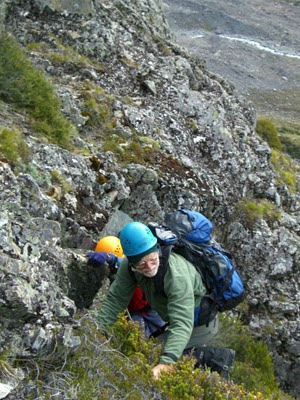The forecast was less than inspiring, but March 26-29 2010 was when the trip had to be due to family and work commitments of the members. We were Shane, myself, and Joan, a Kiwi born in Durham.
We started off up the Cameron Valley, heading for the Arrowsmiths, an offshoot of the main divide in New Zealand's South Island. We were heading for Pito Peak, 2419m. Joan and I had attempted it earlier in the year, but failed, due to leaving too long an approach on the summit day. So leaving the Cameron Valley, we crossed the Wild Man's Brother range, and descended into the South Ashburton valley, which led up to a glacial basin at the foot of the Arrowsmiths. Joan and I had to wait while Shane, in true new Kiwi fashion, took his boots off to cross the river, then we ruefully continued past the comfortable hut which had proved to be too far from the summit on our last trip.
There were plenty of good camping spots near the start of the climb. The Nor'-West wind got up magnificently during the night. Modern tent design is wonderful, allowing tents to duck out of the wind, but
nevertheless the whacks on your head from the roof and walls of your tent during gusts doesn't make for a good night's sleep. The wind was still up in the morning, and it wasn't until 8am that it dropped enough to make a start worthwhile.
The start was approx. 600m of fairly steep scrambling, over tussock, rock, and spaniards*. this led to relatively gentle basins, then a final rubbly climb to the summit. In retrospect, Spring would have been a better time for the climb, when the rubble would have been snow-covered. The summit view was indistinguishable from that often obtained from a Munro- that is, sleety, claggy drizzle. However, we were all delighted to have got there.
During the descent, a truly mystifying noise began from the ridge 100m. or so above us, resembling a swarm of bees hugely amplified. We didn't know what it was, and so prudently scurried behind a large boulder. There was no wind where we were, but the others could see debris flying higher up the ridge. I can only think that it was a williwaw, or small whirlwind, the kind that regularly removes roofs from groups of a few houses here and there in New Zealand. Shane offered thealternative view that it could be a portal to another dimension. either way, we were well out of it.
* In NZ Wild Spaniards, genus aciphyllum, are an alpine plant, grass-like, but with astonishingly sharp spines.














